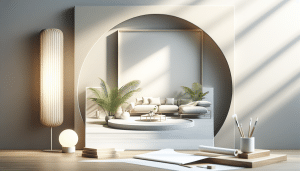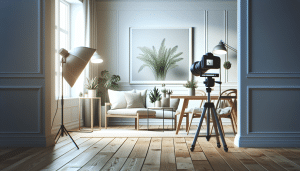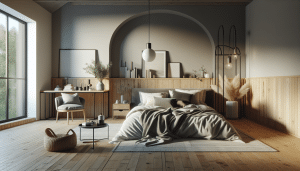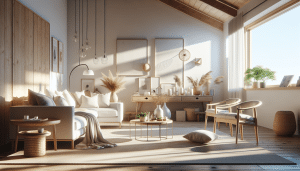Surprising Ways Interior Styling Transforms How You Feel
Samantha Lee October 16, 2025
Discover how thoughtful interior styling not only refreshes your living space but also influences your mood and well-being. Learn practical design ideas that blend comfort, aesthetics, and wellness to create a home environment you’ll truly enjoy.
Creating Space That Reflects Your Personality
Interior styling goes beyond surface aesthetics—it’s truly about expressing individuality. By incorporating unique colors, textures, and cherished items, each room becomes a canvas that mirrors the people who live there. Research shows that even small changes in decor, like arranging personal photos or displaying handmade crafts, can trigger positive emotional responses and foster a sense of belonging (Source: https://www.psychologytoday.com/us/blog/brain-wise/201709/the-psychology-home-environments). Thoughtful interior styling empowers you to showcase your story, bringing authenticity and comfort into everyday life.
The furniture choices and layout of your space influence both flow and energy. For example, arranging sofas to encourage conversation can strengthen social bonds, while creating cozy nooks can offer refuge after a long day. Using items that have personal significance, from inherited heirlooms to souvenirs from travels, ensures your interior styling reflects your journey and values. These choices can help transform your house into a home, offering an immediate mood boost every time you walk in.
Personal expression isn’t just about what meets the eye. It’s the feeling you get when you enter a room designed just for you and your lifestyle. Incorporating your favorite colors, preferred levels of lighting, and items with sentimental value encourages relaxation and happiness. It’s about creating a sense of place—somewhere you are eager to return to and proud to share with others. This connection between self and space is one reason why interior styling is such a powerful wellness tool.
The Connection Between Home Design and Well-Being
A well-styled space supports both physical comfort and emotional well-being. Studies have found that certain design elements, such as access to natural light, exposure to greenery, and uncluttered surfaces, correlate with decreased stress and improved mood (Source: https://www.ncbi.nlm.nih.gov/pmc/articles/PMC5452227/). Incorporating biophilic elements—like houseplants, wood, and water-inspired decor—brings the calming effects of nature indoors. Interior styling that includes these features helps make relaxation an effortless part of daily life.
No matter the size of your home, organization plays an important role in mental health. Cluttered spaces have been linked to increased anxiety and reduced focus, while tidy, well-organized interiors encourage a calmer mindset (Source: https://www.nytimes.com/guides/smarterliving/how-to-declutter). By prioritizing storage solutions that fit your routines, you can maintain visual harmony and free up mental space for creativity and rest. These daily habits can be reinforced by creating zones in your home that are designated for relaxation, productivity, or entertainment.
Comfort is often overlooked in pursuit of a certain ‘look’, but the most successful styling favors well-being over trend. Think plush armchairs, layered rugs, and adjustable lighting that adapts to your needs. Personal touches, like familiar scents or cozy textiles, have a powerful influence. These choices help build a nurturing environment that supports emotional stability and relaxation long after a stressful day. As research continues to reveal, home design impacts mental balance in more ways than one might expect.
Color Psychology and Mood Enhancement
Color is one of the most influential elements in interior styling. Scientific studies confirm that different hues can affect mood and productivity. For instance, blue tones often evoke calm and serenity, while yellow can inspire optimism and creativity (Source: https://www.scientificamerican.com/article/the-color-of-your-office-can-affect-your-mood-and-productivity/). Choosing a color scheme that aligns with your preferences and desired atmosphere sets the emotional tone for each room. Accent walls, decor objects, and textiles offer a low-commitment way to explore new shades without a major overhaul.
Some design experts recommend starting with neutral foundations and layering in pops of bold color through accessories. This method allows greater flexibility as your taste evolves, and it also keeps the space visually interesting. While some may prefer soft, cool tones for bedrooms and bolder hues in social spaces, there’s no universal formula—personal comfort comes first. The deliberate use of color is a creative outlet that helps reinforce your mood goals, whether that means energizing mornings or peaceful evenings.
Lighting further amplifies the effect of color. Sunlight can make colors appear more vibrant and expansive, while different types of bulbs shift moods—from cozy and warm to bright and energizing. Smart lighting systems let you tailor the ambiance throughout the day, complementing your color choices and boosting well-being. The combination of tailored hues and thoughtful lighting proves interior styling isn’t just visual—it’s deeply experiential.
Functional Styling: Balancing Beauty and Practicality
Practicality is essential for a home that feels as good as it looks. Interior styling is not about sacrificing comfort for style. Instead, it’s about blending form and function. Well-placed furniture supports easy movement, while multi-use pieces help maximize every square foot. Storage ottomans, folding desks, and modular shelving all contribute to a flexible layout. Adapting these ideas offers both aesthetic pleasure and convenience for real-life demands (Source: https://www.archdaily.com/966116/how-to-design-the-perfect-home-for-every-task).
Functional styling also means embracing your lifestyle. Pet owners might select durable fabrics; families with young children may opt for easy-to-clean surfaces and soft corners. The best interior styling adapts to evolving needs—hosting guests, remote work, or hobbies that require dedicated zones. By considering practicality at the start, you avoid clutter and frustration down the line. The result? A home that supports your routines and evolves with you.
Combining functionality with beauty doesn’t require elaborate renovations. Sometimes, arranging furniture to capture natural light, hanging mirrors to expand perceived space, or using open shelving for display and storage brings immediate improvement. These small stylistic shifts foster a sense of order and harmony, making the home feel more manageable and inviting. Thoughtful interior styling encourages both visual pleasure and effortless living.
Embracing Sustainable and Mindful Decor Choices
Sustainability is increasingly at the heart of interior styling. Eco-friendly materials, vintage items, and locally crafted pieces reflect growing awareness of conscious consumption. These choices can lower your environmental impact while adding character and uniqueness to your home (Source: https://www.architecturaldigest.com/story/sustainable-interior-design). Integrating natural elements—bamboo flooring, recycled glass, or reclaimed wood—creates warmth and tells a story of care for the planet.
Mindful styling is also about buying less but choosing better. Investing in quality over quantity means opting for timeless designs and long-lasting materials. This approach reduces waste and fosters a deeper connection to your possessions. Upcycling, repurposing, and DIY projects inject personality without further straining resources. The pleasure of curating a space thoughtfully outweighs the fleeting excitement of following fast-changing trends.
Carefully selecting home fragrances and natural cleaning products further supports a healthy environment. Simple routines—like airing out rooms, washing textiles with gentle soaps, and displaying houseplants—contribute to indoor air quality. Mindful decor habits benefit both the residents and the world outside their window. Interior styling becomes a conscious act that adds value on multiple levels, including wellness and eco-friendliness.
Building Community and Experience Through Design
Interior styling is not just for private enjoyment. It also shapes the way people connect and share experiences. Open-concept layouts, inviting seating arrangements, and communal dining areas encourage interaction and hospitality. Spaces designed with flexible furniture and adaptable lighting can quickly transform from quiet retreats to lively gathering spots. Hosting becomes stress-free when your home accommodates a range of moods and activities (Source: https://www.houzz.com/magazine/how-to-turn-your-home-into-a-friends-and-family-magnet-stsetivw-vs~121126870).
Whether it’s a weekend brunch or impromptu crafts with friends, a well-styled home brings people together. Thoughtful zones for entertainment, reading, or shared hobbies foster connection and creativity. Even a small balcony or cozy entryway can become a welcoming invitation for meaningful moments. Interior design’s power to build community is both subtle and profound, encouraging togetherness and joy.
Many people now seek virtual ways to share their home spaces, from video calls to social media. Personal backdrops and comfortable setups not only express identity but also help maintain social contact. As lifestyles evolve, remote work and digital gatherings influence design. The flexibility to adapt spaces for both privacy and connection keeps interior styling relevant and enriching well into the future.
References
1. Sander, L. (2017). The Psychology of Home Environments. Retrieved from https://www.psychologytoday.com/us/blog/brain-wise/201709/the-psychology-home-environments
2. Bratman, G.N. et al. (2017). Nature experience reduces rumination and subgenual prefrontal cortex activation. Proceedings of the National Academy of Sciences. Retrieved from https://www.ncbi.nlm.nih.gov/pmc/articles/PMC5452227/
3. Smarter Living. (n.d.). How to Declutter Your Home (and Life). The New York Times. Retrieved from https://www.nytimes.com/guides/smarterliving/how-to-declutter
4. Scientific American. (2020). The Color of Your Office Can Affect Your Mood and Productivity. Retrieved from https://www.scientificamerican.com/article/the-color-of-your-office-can-affect-your-mood-and-productivity/
5. ArchDaily. (2021). How To Design the Perfect Home for Every Task. Retrieved from https://www.archdaily.com/966116/how-to-design-the-perfect-home-for-every-task
6. Architectural Digest. (2019). The Ultimate Guide to Sustainable Interior Design. Retrieved from https://www.architecturaldigest.com/story/sustainable-interior-design







